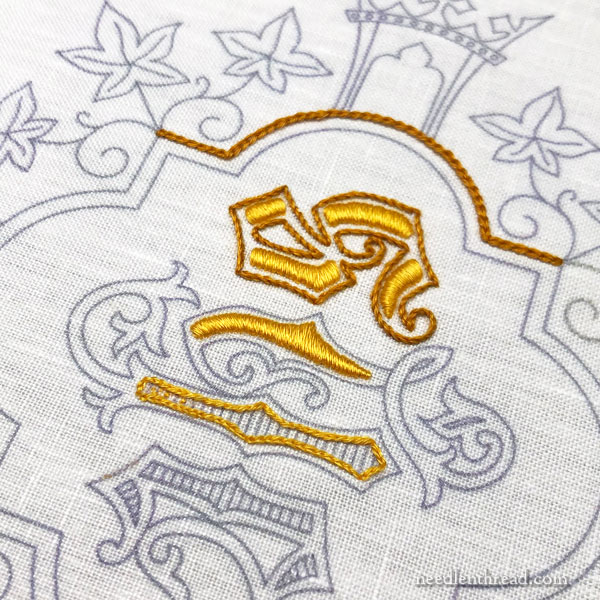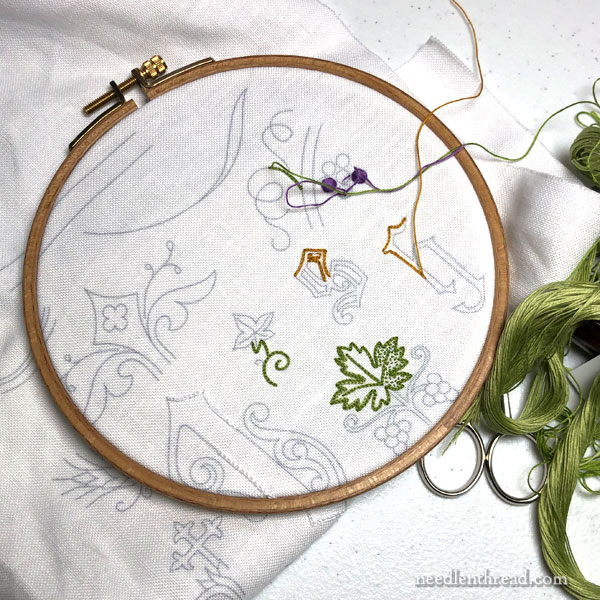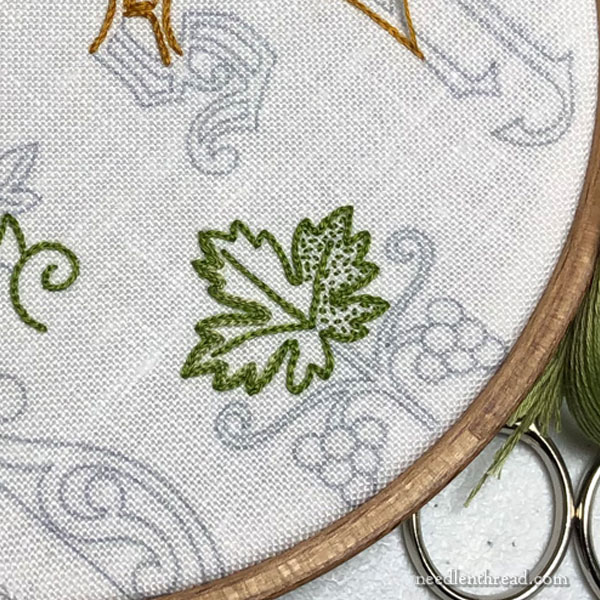Recently, I was asked if I would teach a local class on ecclesiastical embroidery – specifically, how to make what is called a pall.
Things being what they are, the preparations were a little rocky. And I haven’t progressed as far as I’d like in my sample project for such a class.
And in fact, I’m not sold on my sample project, as little as it has progressed!
But I’m going to show it to you anyway and share some thought processes…

To keep the long story short, I’ll explain what a pall is. I’ve talked about palls before here on Needle ‘n Thread, because I’ve embroidered many, and I’ll link to some of those articles below.
Essentially, it’s a linen square that covers the chalice during Mass.
Different churches have their preferences for size, style, decoration, and so forth, but in the Catholic Church (and also in the Anglican), the one “rule” for a pall is that the fabric that touches the chalice must be linen.
Today, the pall is usually stiff, so it is made up into a sort of pocket and then a thin board is inserted inside the pocket. The pocket is stitched closed so that it tightly hugs around the thin board. Sometimes, there’s a decorative edging on the pall, made of fine lace, needle lace, tatting, or something similar.
The size of the finished pall varies, but an average size is about 6-7″. I make mine 6.25″.
The design I’m using on this particular pall is found in my Church Patterns e-book.
When I started gathering ideas for the class, I pulled together a dozen patterns to give the participants a range of designs to choose from. The designs ranged from simple to complex, as I didn’t know what level of stitchers would be involved in the class. This design falls in the middle range – it’s not simple, but it’s not as complex as a couple of the others.

I put together a kind of doodle cloth – or sampler cloth – so that I could try out various threads and stitches on different elements that I extracted from the designs.
I figured this would be a good thing to give to the class participants, so that they also could test stitches, threads, and ideas before they actually worked on the design itself.
To test threads, I pulled out cotton embroidery threads only, and specifically, floche, regular DMC stranded cotton, and coton a broder whitework threads. (You can read about floche here if you’re not familiar with it, and you can read about coton a broder here if you’re not familiar with it. And you can see the two threads compared and read about their differences here.)
Palls are often embroidered white-on-white, so I wanted to test three weights of coton a broder: 20, 25, and 30. These are the weights commonly available today (you can find them through shops like Lacis, online).
Normally, I would stitch a pall in silk. But with beginners, I figured that cotton would be a better start.
To make a sample project that’s a little more visually accessible, I decided to work my sample project in color. And to do this, I settled on floche over regular DMC stranded cotton.

One thing that I love, love, love about floche is that it makes such a pretty split stitch. There are few times that split stitch plays a starring role (unless it’s in Opus Anglicanum!), but when you’re using floche, split stitch makes a lovely filling and a lovely line stitch for visible lines.
You can see an example of split stitch as a filling with this embroidered monogram. It works well!
The green leaf above is split stitched around the edge, and then I tried some seed stitch on one side and on the other, I tested another line of lighter green split stitch inside the main outline.

The trouble I’m having here, in my head, is that, as much as I love floche, it is relatively heavy compared to, say, one strand of DMC stranded cotton (one strand taken from the six).
And with this design, being somewhat busy, the floche might be a bit much.
I haven’t decided absolutely on this.
Floche makes such a beautiful satin stitch. And it’s a lovely thread to work with. But in the end, will I find the finished embroidery too chunky for the design?
I ponder this.
But I think I’m going to keep moving forward, anyway. If nothing else, it will make a good sample for future classes.
So that’s another project I have going. I’m not 100% sold on it, but it might grow on me!
On the home front, mom is still in the hospital. I have no idea how things will work out in that direction, either.
In the meantime, have a wonderful weekend and hopefully, next week, I’ll be back to a more regular schedule!
Read More About Palls
Ecclesiastical Embroidery: Pall Design (grapes, IHS pall design)
Finishing Work on Hand Embroidered Pall – the small red cross
Simple Stitches for Beautiful Results on a Whitework Pall
Adding Texture with Seed Stitch on a whitework pall







Continuing to pray for your mom, your family, and you.
Mary, since it’s a sample why not work 1/2 in Floche and 1/2 in Silk (or whatever).
I often try a variety of threads on “Doodle Cloth”. My first instructor insisted on
every doodle cloth having at least 2 kinds of thread and honestly she preferred 4.
I asked her once about it and she said, keeps the rut from getting too deep.
Yes, that’s the point of the doodle cloth. The actual project, though, is a completed sample project for the class – not a sampler. If I’m going to spend the time making it, I want to make it into something usable. 🙂
Hi Mary,
My best wishes for your Mom, and for all of your family during this stressful experience.
I am an Episcopal priest, and I would be interested in any class that you might offer on ecclesiastical embroidery. Can you keep me posted on it?
All blessings,
Mary Lou McKennry
So glad to hear that your mother’s making progress, Mary!
You embroider palls in silk? What about washing them? Inevitably, palls get small wine stains on the underside. Ours have white cotton embroidery; fortunately, the stiff board inside is either a very thin Masonite or plexiglas, so you don’t have to remove it before washing. I’ll soak the pall in a small tub of water with Oxiclean powder and a bit of laundry detergent, and poof! it comes out pristine. But Oxiclean can’t be used with silk. How do you handle this?
This would make a lovely pall in floche. Maybe not as dainty as white work, but very seeable from a distance. Any user should love it.
Your ecclesiastical work is exquisite. Have you ever made a funeral pall used on a casket? When I was in seminary my internship site asked me to help them make one. Fortunately I had good help.
Well, that’s a whole different kettle of fish! By comparison, a funeral pall is huge. It’s usually decorated with ready made trim.
Hi Mary,
Thanks for the update on your mother, will pray she continues to improve.
On the sampler, since floche is DMC, to eliminate some of the chunkiness could stranded floss be used in combination with the floche? The thickness of the floche could be set off with floss of the same color.
Yes, perhaps. I don’t necessarily like combining different types of thread on this kind of embroidery project, but it is something I’m exploring. I think I’d rather just use regular DMC stranded cotton for all of it, though, instead of combining, if I need to. We shall see!
Dear Mary
What a lovely idea to teach a local class on ecclesiastical embroidery and I’m sure the children will have a very thorough learning experience with you as their teacher. I love the idea of a doodle cloth to test different thread and stitches for your pall. I agree with you that floche is one of my favourite threads I love sewing with it, it is so smooth and just glides through the fabric. But as you say you might need a thinner look such as a nice silk. Thank you for sharing with us your ecclesiastical embroidery and for the photos, I look forward to the progress on this project. Take care
Regards Anita Simmance
I know the floche is thicker than you’d like but the yellow you’ve stitched so far looks plump and lovely! And, from a beginner’s perspective, I know I found it worlds easier to work with a non-divisible thread. I worked with perle cotton. Not having to worry about catching the floss strands made it so much easier to concentrate on the stitching. Whatever you decide I know it will be beautiful! Best wishes to you, your Mom and your family 🙂
What type of linen do you use for your ecclesiastical work?
It really depends on the project and what it’s for. There are many out there, and I never use just one – it really just depends! This particular on this project is Tailor’s Chalk.